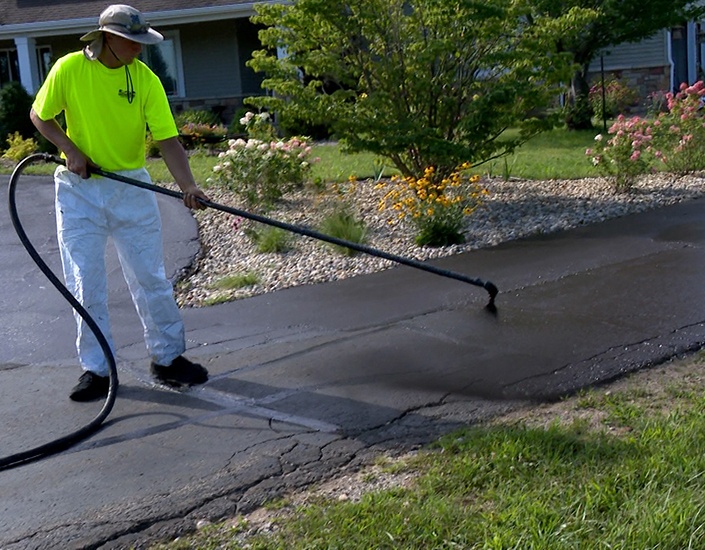Raise Security and Charm: Angled Parking Area Solutions with Asphalt Sealing
Raise Security and Charm: Angled Parking Area Solutions with Asphalt Sealing
Blog Article
Hot Mix Asphalt: A Lasting Solution for Sidewalk
Warm Mix Asphalt (HMA) has emerged as a leading sustainable selection for sidewalk remedies, providing a myriad of environmental benefits and innovative modern technologies. As the need for environment-friendly building methods grows, checking out the nuances of HMA's sustainability can supply important insights right into the future of sidewalk solutions.
Ecological Benefits of Warm Mix Asphalt

Furthermore, Warm Mix Asphalt helps to alleviate city warm island results. Its dark color takes in sunlight, lowering the quantity of heat showed back right into the environment compared to lighter-colored sidewalks. This can lower ambient temperatures in city locations, lowering the need for a/c and eventually reducing power usage.
On top of that, Warm Mix Asphalt adds to boosted stormwater monitoring. Its porous nature allows water to recharge and infiltrate the pavement groundwater products, decreasing runoff and the risk of flooding. These environmental benefits make Warm Mix Asphalt a sustainable selection for paving roadways and freeways.
Energy Efficiency in HMA Production
Is power efficiency a critical variable in the production of Warm Mix Asphalt (HMA)? Power plays a significant duty in the production of HMA, influencing both price and environmental sustainability. One essential facet of power efficiency in HMA manufacturing is the use of cozy mix asphalt (WMA) technologies.
Furthermore, developments in plant modern technologies have led to more energy-efficient HMA production procedures. By enhancing energy usage in HMA manufacturing, the sector can reduce its carbon footprint while preserving high-quality pavement materials.
Recyclability of Warm Mix Asphalt
The recyclability of Warm Mix Asphalt (HMA) is a pivotal aspect of its sustainability and long-lasting environmental influence. HMA is just one of the most recycled materials in the United States, with over 100 million lots of redeemed asphalt sidewalk (RAP) being recycled annually in new pavement construction. Recycling HMA provides a number of ecological advantages, such as lowering the demand for virgin products, decreasing power intake throughout manufacturing, and lowering the quantity of waste sent out to land fills.
The procedure of reusing HMA entails crushing the existing sidewalk, squashing it into smaller pieces, and mixing it with new aggregate and asphalt binder to develop a recycled mix. This recycled mix can often perform along with and even far better than traditional HMA, while needing less raw products and creating lower greenhouse gas emissions. By including RAP right into brand-new sidewalk projects, roadway firms can conserve natural deposits, minimize expenses, and minimize the ecological footprint of road construction and upkeep activities. In general, the recyclability of HMA plays a considerable role in advertising lasting methods within the pavement sector.

Long-Term Efficiency of HMA
Asphalt sidewalks show toughness and durability over an extended duration, mirroring the lasting efficiency of Warm Mix Asphalt (HMA) The durability of HMA can be credited to its capability to withstand heavy traffic lots, extreme climate condition, and the results of aging. Research studies have revealed that properly designed and appropriately built HMA pavements can last for two decades or more with routine maintenance. The secret to taking full advantage of the long-term efficiency of HMA exists in utilizing high-quality products, complying with best techniques in building, and executing effective upkeep methods. Appropriate drainage, regular assessments, and timely repair services are necessary for protecting the structural honesty of HMA pavements with time. Furthermore, developments in HMA modern technology, such as the usage of polymer-modified binders and warm mix asphalt, have actually even more enhanced the toughness and long life of HMA pavements. By prioritizing high quality building and construction and upkeep techniques, HMA remains to prove itself as a economical and lasting service for resilient sidewalk infrastructure.

HMA: Resilience and Sustainability
Showing both durability and sustainability, Warm Mix Asphalt (HMA) has actually become a foundation in the building and construction of long-lasting sidewalk frameworks - hot mix asphalt. HMA's sturdiness originates from its ability to endure heavy lots, rough weather, and high website traffic quantities, making it a dependable option for roads, freeways, and airport terminal paths. The composition of HMA, which generally includes accumulations, binder, and filler, plays a critical role in enhancing its longevity and resistance to damage
Additionally, HMA's sustainability hinges on its recyclability and energy-efficient manufacturing procedure. The capacity to recycle redeemed asphalt sidewalk (RAP) in brand-new HMA combinations lowers the need for virgin products and minimizes the ecological effect of sidewalk construction and maintenance. In addition, the power efficiency of producing HMA hinges on its lower blending temperature levels compared to various other sidewalk materials, causing decreased energy usage and greenhouse gas discharges.
Final Thought
To conclude, hot mix asphalt (HMA) provides a sustainable option for pavement with its environmentally pleasant attributes. HMA's recyclability, power effectiveness in production, and long-lasting longevity make it an eco-friendly selection for roadway building. By preserving natural deposits, minimizing waste, and reducing greenhouse gas discharges, HMA plays an important function in promoting sustainability in infrastructure growth. Its capacity to alleviate metropolitan warm island impacts even more underscores its relevance in developing ecologically aware and durable sidewalk systems.
HMA is one of the most recycled materials in the United States, with over 100 million bunches of recovered asphalt sidewalk (RAP) being recycled yearly in brand-new pavement building and construction.The process of reusing HMA involves grating the existing sidewalk, squashing it into smaller sized pieces, and mixing it with brand-new accumulation and asphalt binder to create a recycled mix.Asphalt sidewalks show sturdiness and strength over an extended period, mirroring the lasting performance of Hot Mix Asphalt (HMA) In addition, developments in HMA modern technology, such as the use of polymer-modified hot mix asphalt binders and cozy mix asphalt, have even more improved the longevity and longevity of HMA pavements. The ability to reuse reclaimed asphalt pavement (RAP) in new HMA blends lowers the demand for virgin materials and reduces the environmental effect of sidewalk construction and maintenance.
Report this page